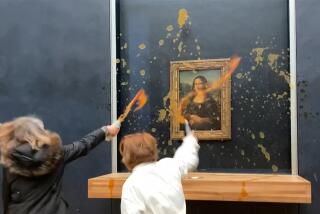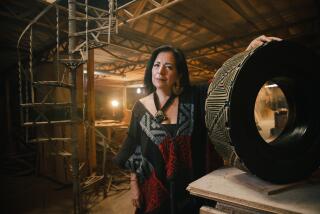Vietnam’s blossoming contemporary art scene, on full display in L.A.
Traveling to Vietnam as a 22-year-old tourist had a profound effect on artist Thinh Nguyen. Born in Bao An, Vietnam, Nguyen immigrated to the U.S. at 11, lived in Orange County and didn’t truly learn about Vietnam until returning for the first time in 2006.
After the trip, Nguyen had another revelation: The artist didn’t know much about the U.S. either.
In 2014 and ’15, Nguyen hitchhiked across 46 states, staying with 70 to 80 strangers in an attempt “to get to know the U.S. in a very physical and in a performative way.” At times harrowing, and other times heartwarming, the experience taught the artist to let go of “preconceptions of certain areas,” Nguyen said, and connect with people with differing political ideologies.
Remnants of Nguyen’s project — photographs taken from cars and of sleeping surfaces paired with Nguyen’s journal — make up the installation “Across the American Plains.” The work is part of “Where the Sea Remembers,” a project showcasing work from an emerging generation of Vietnamese artists at the Mistake Room exhibition space in South L.A.
The Mistake Room’s “Where the Sea Remembers” proves to be an ambitious exhibition showing the work of contemporary artists.
A window into Vietnam’s expanding arts scene, “Where the Sea Remembers” features work from 15 artists and collectives, including Trong Gia Nguyen, whose paintings based on family photos address the instability of memory; Thu Van Tran, whose abstract photographic work confronts atrocities of the Vietnam War; and Tuan Andrew Nguyễn, whose thermal survival blankets draw connections between the artist’s experience with displacement and the millions who are currently displaced.
The exhibition explores tension in the artists’ inherited histories — trauma that they didn’t experience themselves, said César García-Alvarez, artistic and executive director of the Mistake Room and curator of “Where the Sea Remembers.” ”How they carve out their own narrative without the past replacing that.”
The year 2007 — when Vietnam joined the World Trade Organization — is an important point of context for the exhibition. It marks a peak in the country’s efforts to open its economy, soften its borders, and expand tourism and travel opportunities for Vietnamese citizens.
Vietnam’s opening to the outside world had a major impact on its art, said Nora Taylor, professor of South and Southeast Asian art at the School of the Art Institute of Chicago.
Because of its isolation, Vietnam was shut off from most global contemporary art movements.
Traditional Vietnamese art is often nationalistic and patriotic — landscapes of the countryside or portraits of people, farmers and soldiers — “celebrating the population and what they contribute toward the economy,” Taylor said.
And at state-sponsored art schools, artists typically learned “life drawing or landscape drawing or drawing from nature, not leaving much to their imagination,” she said.
In 1986, Vietnam began implementing economic reforms that opened the country, bringing an influx of tourists and attention to its traditional art. “That evolved into younger artists not wanting to do that kind of painting,” Taylor said. “They started looking for opportunities to develop their styles.”
And with the rise of the internet, artists were able to access new media, be exposed to an international vocabulary and start making drastically different art, Taylor said.
But the biggest influence on contemporary art in Vietnam was the arrival of Viet Kieu, or overseas Vietnamese, artists who moved back after their families fled the country. “All of this comes together to form a pretty vibrant artistic scene that isn’t completely dominated around narratives of war and trauma,” García-Alvarez said.
Although artists still work under a communist regime, Vietnam’s art scene is expanding with independent initiatives including nonprofit art center Sàn Art, artist collective the Propeller Group and the Factory Contemporary Arts Centre.

Thao Nguyen Phan, Where the Sea Remembers artist
“Where the Sea Remembers” artist Phan Thảo Nguyễn, whose series of watercolor drawings reframe a Westerner’s account of Vietnam, said via email the “raw state” of Vietnam’s art scene — “no institution support, no collector, no art market, no official art history” — is both challenging and exciting.
There’s “endless inspiration for artists,” she said. The country is also rich in local materials, which makes it “reasonable to realize ambitious art projects.”
Vietnamese art has been shown in the U.S. only relatively recently. Many of the artists featured in “Where the Sea Remembers” have never been exhibited in L.A.
During the years of war, “There was no way these artists were being shown in America because the name would be considered an enemy of the United States,” Taylor said. And those perceptions lingered long after the war.
Even now, Vietnamese art in the U.S. can be controversial.
In 2009, “F.O.B. II: Art Speaks,” a Santa Ana exhibition organized by a Vietnamese artist group, closed after protests from the Vietnamese American community across Southern California. One of the more provocative pieces in the exhibition was a photograph of a girl in Vietnam wearing a red tank top with a yellow star, representing the country’s official flag.
“Where the Sea Remembers” doesn’t seem interested in “engaging certain politics,” Taylor said. It’s more interested in “the politics of memory and refugees.”
García-Alvarez said he hopes the exhibit functions as a history lesson, a reminder of the parallels between the Vietnamese refugee experience and refugees today.
“A lot of the context in which these artists are practicing [is] the direct result of U.S. intervention in the affairs of other countries,” he said. “It was a conversation that we decided not to necessarily put at the forefront so that people could actually engage with the work.”
"Where the Sea Remembers"
Where: The Mistake Room, 1811 E. 20th St., L.A.
When: Open Wednesdays-Saturdays, 11 a.m. to 6 p.m., through Oct. 12
Admission: Free
Info: www.tmr.la
More to Read
The biggest entertainment stories
Get our big stories about Hollywood, film, television, music, arts, culture and more right in your inbox as soon as they publish.
You may occasionally receive promotional content from the Los Angeles Times.











